The John B. Stetson Company was known for its iconic “Boss of the Plains” cowboy hat, but the once-giant American hat manufacturer produced styles for city slickers as well. Stetson’s advertisements for derbies, fedoras, panamas, and more led the trends of men’s headwear in the young century.

Click to Enlarge
The bowler hat, or derby, was a working-class British phenomenon that eventually found favor with American urbanites. Before René Magritte and Stanley Kubrick turned the bowler into a symbol of oddity, it was a lid for commoners and the well-to-do alike.

Click to Enlarge
The Stetsonian fedora was a darb of a choice of headwear for entertaining a young flapper in the Roaring Twenties. Just add giggle juice.

Click to Enlarge
The sleek style of illustration — clean lines and minimalist composition — is so compelling you might not notice he isn’t wearing the hat. The ’20s marked the end of Stetson’s appeal to young men as the Great Depression warranted a focus on value.
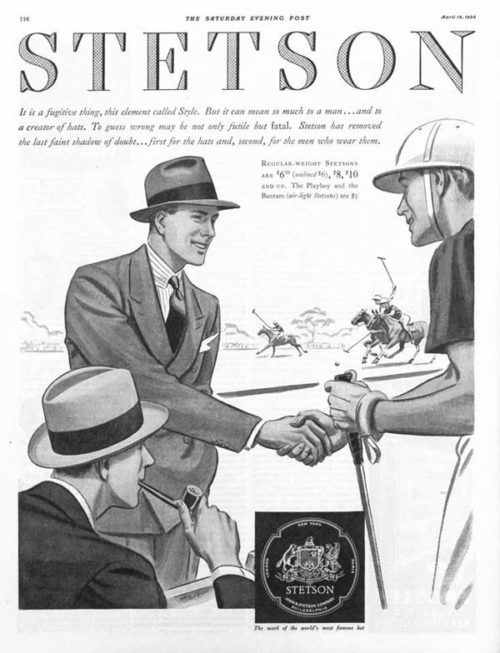
Click to Enlarge
Could a Stetson Playboy save your life? Probably not, but who could afford to take that risk?

Click to Enlarge
Worldliness and culture was a defining feature of Stetson’s cultivated demographic. The chapeaus caught on, even if Esperanto never did.
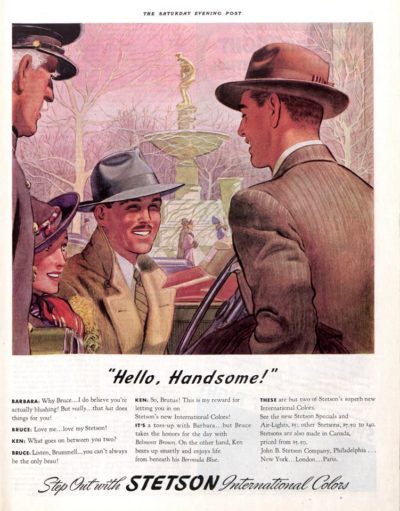
A bizarre, passive-aggressive love triangle might seem an odd approach for selling a hat. Appeals to a man’s romantic life, career, and dignity were common sales tactics for the fast-paced urban dweller.

Click to Enlarge
As the war captivated the attention of every American, Stetson found its customer base returning from overseas fighting. The “loose lips sink ships” adage is employed with an aerial twist.

Click to Enlarge
The Stetson Stratoliner was a fine fedora to “bring him home in style” from the European front. Calls for patriotism and Americana were a surefire ad technique, too. You can still buy a Stratoliner, but the price has scaled from $7.50 to $175.

Click to Enlarge

Click to Enlarge

Click to Enlarge
Celebrities Bob Hope, Bing Crosby, and Douglas Fairbanks, Jr. donned Stetsons for a seasonal 1948 ad campaign along with George Montgomery, Dick Haymes, and Dana Andrews. The movie star endorsements were sure to leave an impression on readers-about-town.
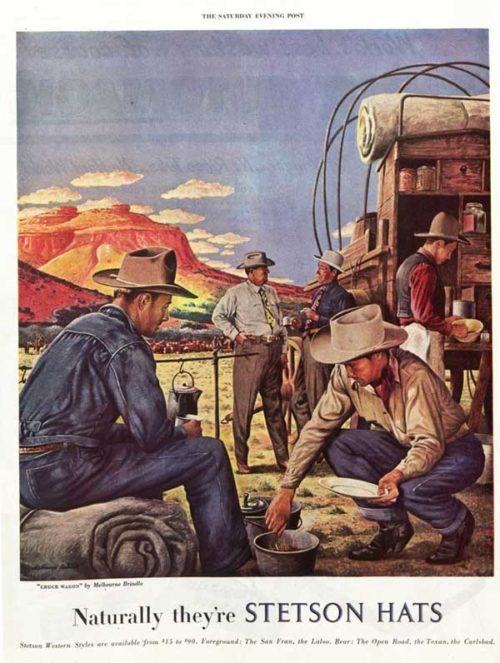
Click to Enlarge
The only advertisement for Western-style Stetsons in the Post shows the cowboy hats in all their Southwestern glory. Ten-gallon or not, the cowboy Stetsons are archetypal of the brand.

Click to Enlarge
Panamas and yacht hats made of straw were a light choice for summer wear, and the boater-style, Barford, was retro even for 1950.
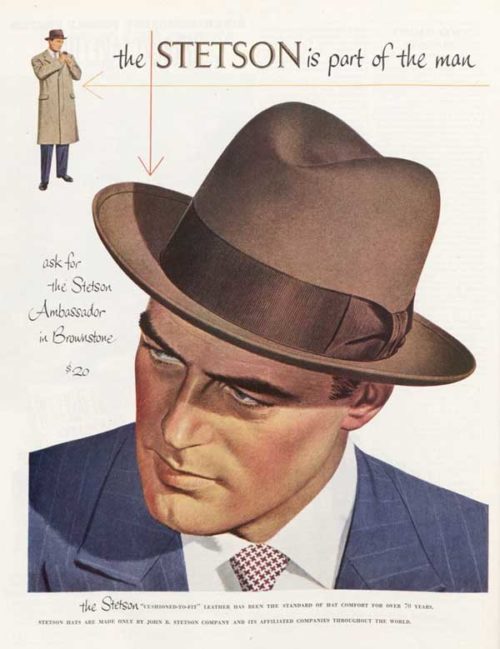
Click to Enlarge
The 1950s would prove to be the last decade for ubiquitous hat-wearing for American men and the last one in which Stetson could command the sleek look of urban fashion. Bowlers and fedoras eventually gave way to stocking and baseball caps or — shockingly enough — no hats at all.
Read “The Fall of the American Hat” for a closer look at the decline of the American chapeau.
Become a Saturday Evening Post member and enjoy unlimited access. Subscribe now


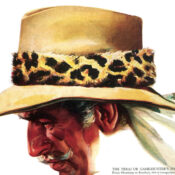
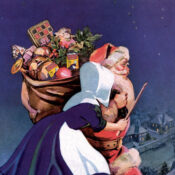
Comments
All wonderful selections Nicholas. I’m jealous of your access to these wonderful vintage Post issues featuring them. Your descriptions are well written also.
Love that derby on top. It really looks like the one The Brown Derby restaurant (LONG gone now!!) was based on.
I love the 2nd ad too at the (?) horse race. There’s no signature, but it looks like a Leyendecker to me from the trademark ‘crinkles and shadows’ of the jacket sleeves, to the ornamentation in the description below.
The ‘loose lips’ ad from 1944 is beautiful I guess, in its own way, but frankly horrifying and shocking at the same time. I wasn’t thinkin’ about any hat looking at that one! The following one was touching and looking toward to the time after the war.
The following three ‘movie star’ ads feature beautiful, outstanding artwork. (Bob Hope was no paleface here, he has a little tan; Bing Crosby more so.) I like the Western Stetson ad too. It shows it’s functional use against the sun, and the background and sky are beautiful also. The variety of hats in the 1950 ad are well represented in the one ad. The final ad shows a really beautiful Stetson.
I wonder if these ads continued in later sections of the Fifties (’52-’55, ’56-’59)? I believe they were in style up to even the mid-60’s, or ’64 anyway.
Baseball caps (especially backwards) make any guy look like an a– —- trying to be “cool”. Are they? Ummm, no; more like a dork trying to be cool, often with a chip on his shoulder and a bad attitude.
I don’t get stocking caps, and don’t want to; not a rapsta or gangsta. I kind of like the 19th century ‘paper boy’ hats with the small ‘bill’ in front, or knit caps that kind of frame your face in a kind of male version of a turban, especially in cold weather.
An ex-girlfriend (around 2002-’04) wore Lana Turner-style turbans and was striking when going out, even if she wasn’t quite LT otherwise. NO other woman was anyhow, then or now. We both cut dashing figures at that Bel Air Hotel party in Brentwood, Nicholas. In hindsight I was under dressed, not wearing any hat, while SHE had that white turban on with that sexy cubic zirconia diamond, and accompanying long dangling earrings to match. Bing Crosby’s Stetson would have been perfect for me that evening, damn it.